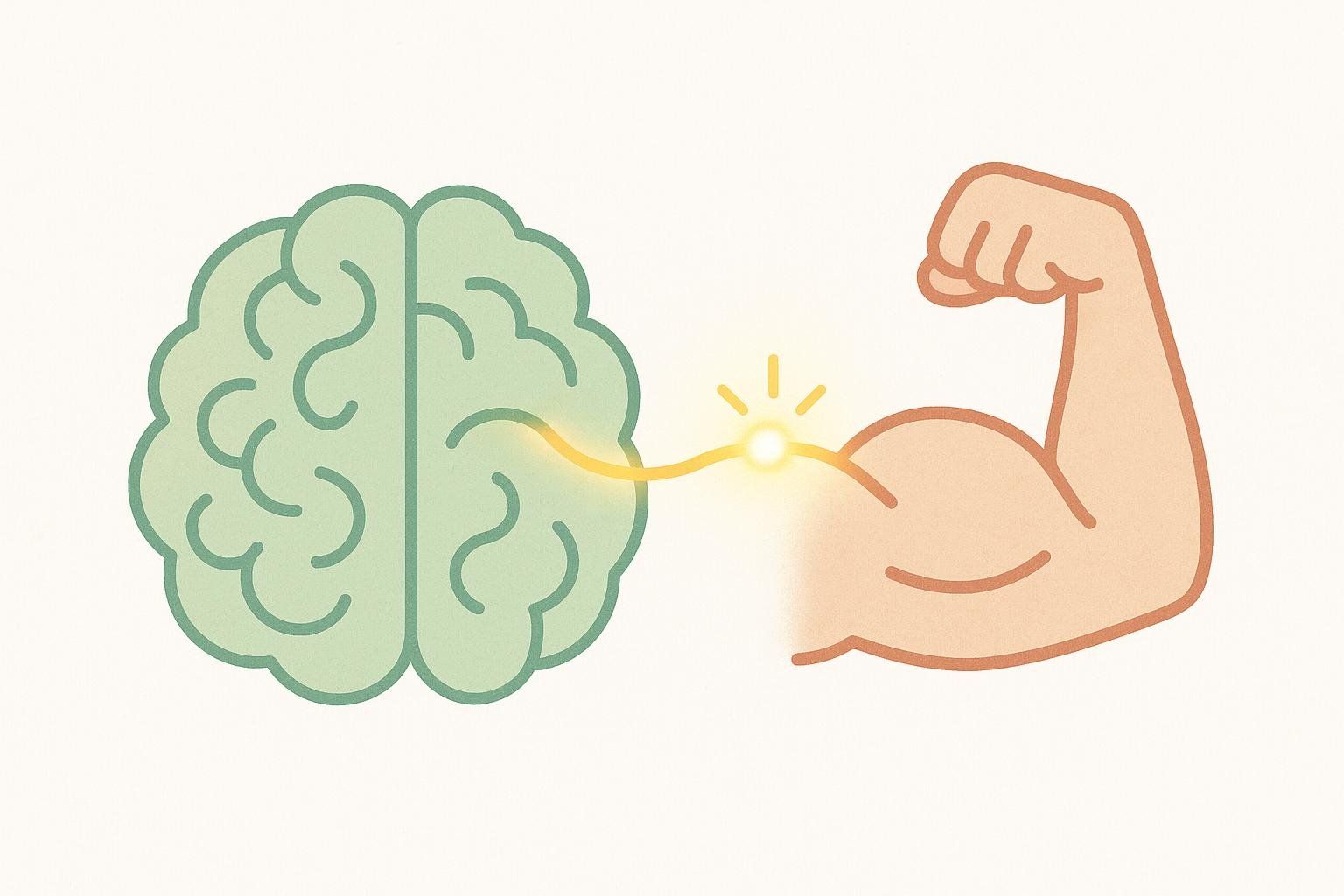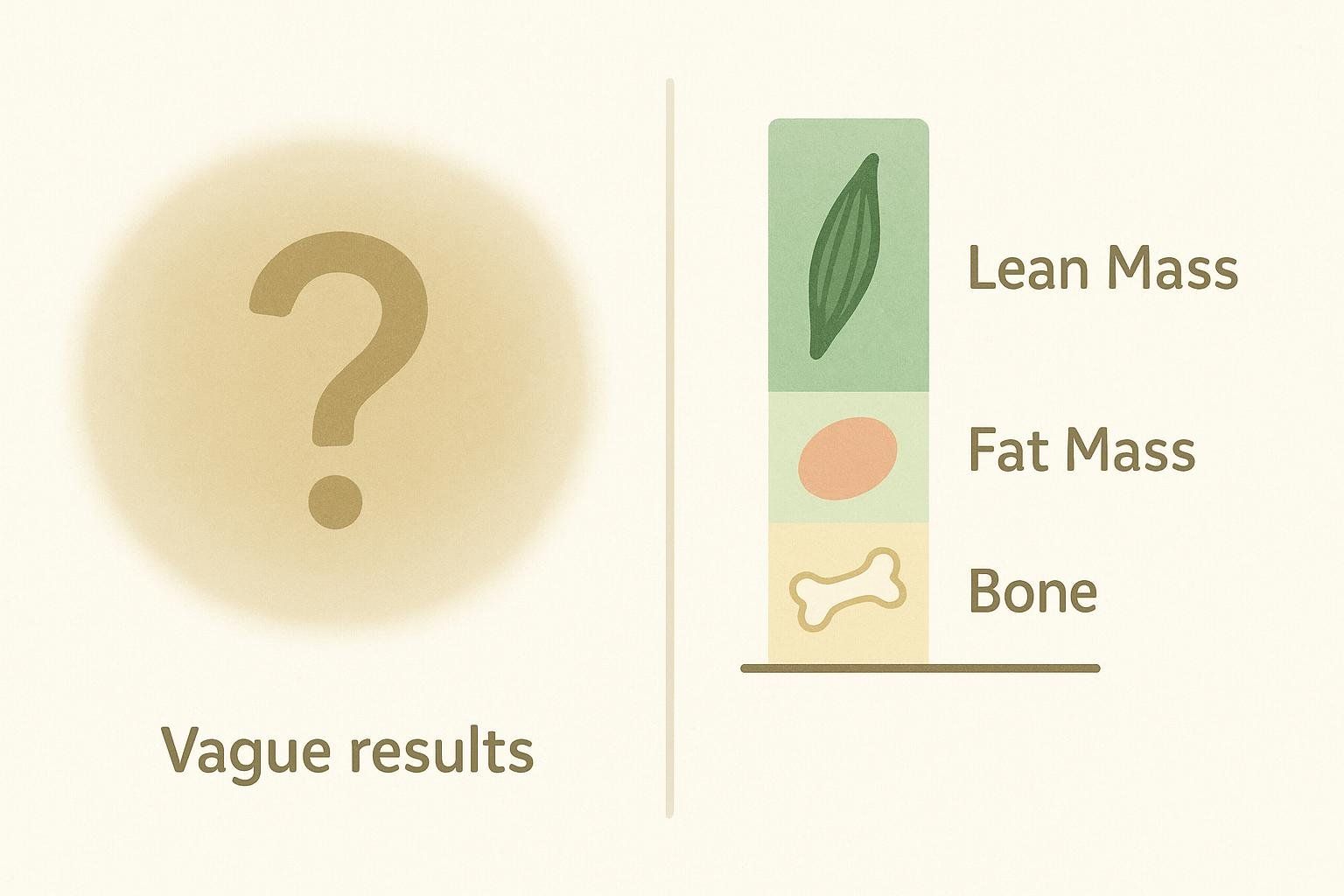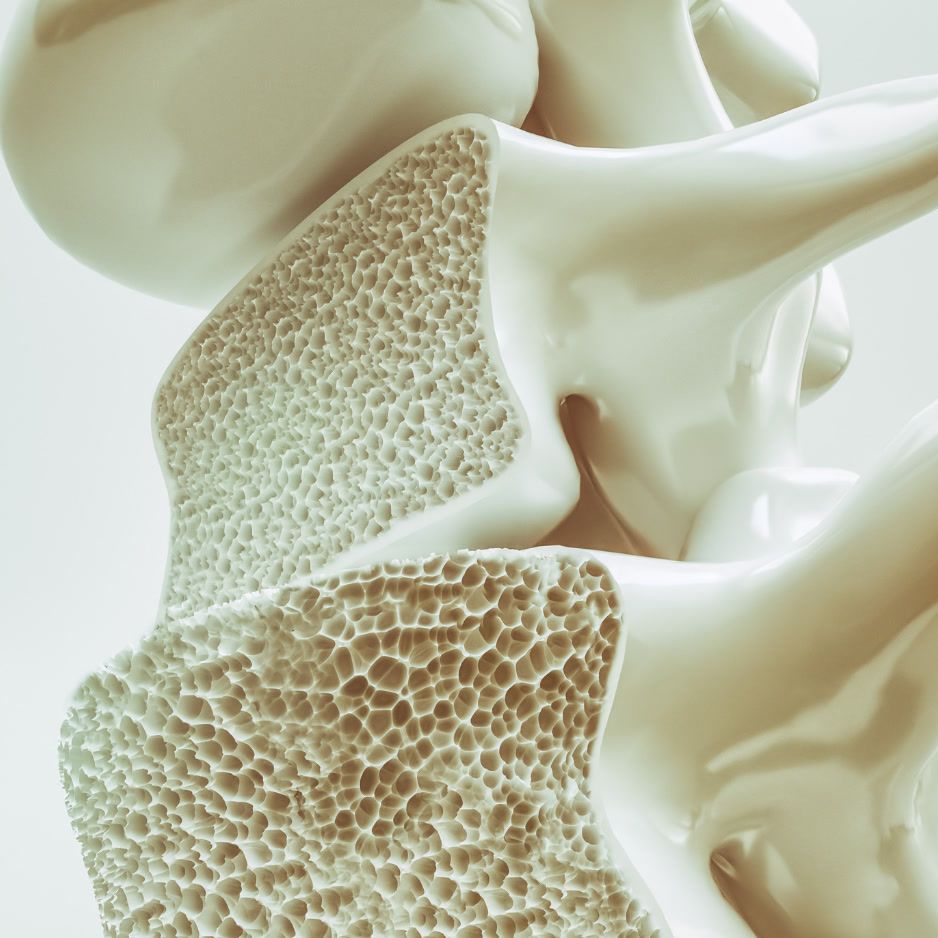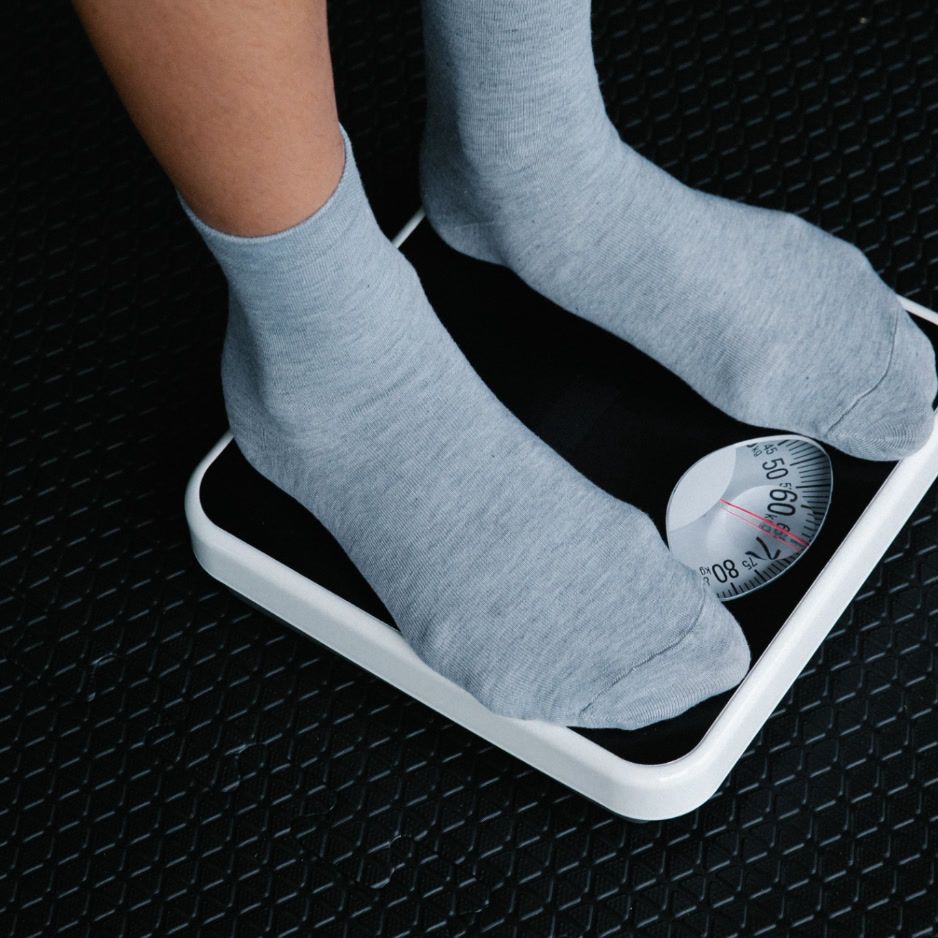How Long Does It Take to Build Muscle?

How Long Does It Take to Build Muscle? A Science-Backed Timeline
At-a-Glance Timeline
- Weeks 1–4: Strength jumps you feel—your nervous system learns to fire more muscle fibers (neuromuscular adaptation) (Cleveland Clinic).
- Weeks 5–12: Muscle fibers start to thicken; most people gain 0.5–2 lb (0.2–0.9 kg) of lean mass per month with smart training and nutrition (Cleveland Clinic).
- Months 4–6: Visible definition appears if progressive overload and adequate protein continue (Cleveland Clinic).
- Month 6 +: Gains slow unless you periodize workouts and prioritize recovery (Bontemps 2022).
Muscle growth is not an overnight process—it’s the result of consistent, strategic effort over time, leading to notable improvements in strength and physique. Below is a phase-by-phase roadmap to set realistic expectations and avoid common mistakes. A BodySpec DEXA scan lets you verify each milestone with data, not guesswork.

Weeks 1–4: The Neuromuscular “Switch-On” Phase
What’s happening inside your body?
- Your brain recruits more motor units, so strength rises noticeably within a few weeks—often well before any visible muscle growth (Cleveland Clinic).
- Enzymes that fuel quick contractions ramp up.
- Muscle-protein synthesis (MPS) spikes after every session, but net growth is minimal.
What you’ll feel
- Loads that were challenging on day one feel lighter by week four; many beginners add extra plates or reps each workout.
- Improved balance and a sharper mind–muscle connection.
Coach’s Corner: Persona-Specific Quick Starts
| Persona | Key Action & Rationale |
|---|---|
| Novice Office Worker (25–35) | 3 × 30-min full-body sessions with squats, push-ups, and rows. Short bouts fit a lunch break while maximizing neural learning across the whole body. |
| Busy Professional (30–45) | 2 × 45-min gym sessions + 1 × 20-min body-weight circuit. Consolidates volume into fewer visits and an at-home micro-workout—ideal for tight schedules. |
| Older Adult (50–65) | Machine circuits 2×/week + brisk walk. Machines stabilize joints during adaptation; walking boosts blood flow for recovery and heart health. |
For deeper guidance on this stage, see Mind and Matter 1: Neural Adaptation.
Weeks 5–12: Early Hypertrophy Takes Over
What’s happening?
- Muscle fibers thicken (myofibrillar hypertrophy) once neural gains plateau.
- Visible changes emerge, especially in arms, chest, and glutes.
- Typical rate: 0.5–2 lb of muscle per month (Cleveland Clinic).
What you’ll notice
- DXA or tape-measure data can show incremental lean-mass increases. Alongside these measurable gains, individuals commonly experience clothes fitting more snugly around the upper body—a perceptual indicator that often accompanies early hypertrophy (Sterczala 2020).
Action Checklist

| Training Parameter | Evidence-Based Target | Source |
|---|---|---|
| Weekly volume | 10–20 working sets per muscle group | (Schoenfeld 2017) |
| Rep range | 6–12 reps | (Schoenfeld 2017) |
| Load | 65–80 % 1RM | (Schoenfeld 2017) |
| Protein | 1.6–2.2 g/kg BW | (Phillips 2015) |
| Calorie surplus | ~+250 kcal/day | (Iraki 2019) |
| Sleep | 7–9 h/night | (Dattilo 2011) |
More pointers for rapid progress are in The Complete Guide to Newbie Gains.

Months 4–6: Building Visible Definition and Stronger Bones
• Satellite cells fuse to existing fibers. These new nuclei support continued muscle growth (Spinazzola 2024).
• Bone density benefits start accruing. Consistent, moderate-intensity lifting stresses bone tissue and contributes to stronger bones. Significant BMD improvements are often measurable within a year of steady training (Frontiers in Physiology 2023).
• Strength continues but slows. Lean-mass gains plateau at roughly 0.5–1 % of body weight per month for intermediates (Iraki 2019).
• Muscle definition becomes obvious. Friends and family usually notice at this stage.
Plateau-Proof Strategies
- Progressive overload cycles: add ~2.5 lb or one extra rep weekly.
- Deload week: every 6–8 weeks to reset fatigue.
- Nutrition audit: track macros for a week; adjust.
- Recovery tech: contrast showers, massage guns, or brisk walks (see Rest Days & Active Recovery).

Month 6 +: The Long Game & Plateaus
Gains slow because your body adapts—but they don’t stop.
Advanced Tactics
- Periodization: cycle strength (3–5 reps), hypertrophy (8–12), and metabolic phases (15–20).
- Creatine: 3–5 g daily boosts high-energy phosphate stores (ISSN Position Stand 2017).
- BodySpec DEXA check-ins every 3 months to ensure lean mass is still climbing, not fat.
7 Factors That Influence Your Muscle-Building Clock
- Training Volume & Intensity – higher weekly set volume produces greater hypertrophy up to individual recovery limits (Schoenfeld 2017).
- Protein Intake – intakes ≥ 1.6 g/kg/day maximize MPS, with older adults likely needing ~1.6–2.2 g/kg (Baum 2016).
- Total Calories – a modest surplus provides building blocks for synthesis (Iraki 2019).
- Sleep & Stress – elevated cortisol suppresses MPS and increases protein breakdown (Braun 2015).
- Age & Hormones – older adults benefit from higher protein and longer recovery windows due to anabolic resistance (Deer 2015).
- Genetics & Fiber Type – fast-twitch dominant muscles tend to display greater hypertrophic potential than slow-twitch fibers (NSCA 2014).
- Consistency – adherence over months and years ultimately determines results.
For deeper dives, read How Fast Can You Gain Muscle?.
Measuring Progress: Why Scale Weight Isn’t Enough
A 5 lb gain could be biceps or belly. Only a DEXA scan distinguishes lean mass, fat mass, and even bone density with ± 1–2 % precision BodySpec Accuracy & Calibration. Learn exactly how in Measuring Muscle Mass: A BodySpec Guide.

BodySpec Insight: Schedule your first scan at week 0, a second at week 12, and a third at month 6 to watch the full timeline come to life.
Sample 12-Week Muscle-Building Blueprint
| Phase | Weeks | Focus | Sets/Reps | Notes |
|---|---|---|---|---|
| Neural | 1–2 | Full-body | 2 × 12–15 | Emphasize form |
| Foundation | 3–4 | Upper/Lower split | 3 × 8–12 | Start progressive overload |
| Growth I | 5–8 | Push/Pull/Legs | 4 × 6–12 | Increase volume, add isolation |
| Growth II | 9–10 | PPL + accessories | 5 × 6–10 | Creatine, calorie surplus |
| Peak | 11–12 | Full-body heavy | 3 × 5 | Intensity focus, deload next |
FAQ
How long does it take to start gaining muscle?
Most beginners log their first measurable lean-mass uptick around 4–6 weeks—right after the neural adaptation phase gives way to true hypertrophy (Cleveland Clinic).
How long after a workout does muscle grow?
MPS rises within 2–3 hours, peaks at 24–48 hours, and returns to baseline by 72 hours in novices; trained lifters recover faster (Burd 2011).
How long does it take to go from skinny to muscular?
Expect 12–24 months of consistent training, surplus calories, and progressive overload to transform an underweight frame into a visibly muscular one (Helms 2018).
Is working out twice a week enough to build muscle?
Yes—full-body sessions that provide ≥ 10 quality sets per muscle group weekly can spur growth, particularly in novices (Ralston 2017).
Can I build muscle while losing fat?
Research shows simultaneous muscle gain and fat loss—body recomposition—can occur, especially in beginners or detrained individuals who combine progressive resistance training with high-protein diets (Barakat 2020).
How much muscle can women gain?
Meta-analyses in mixed-sex novice cohorts report average gains of 1–1.5 kg lean mass in the first 3–4 months, translating to 0.5–1.5 lb per month for many women (Benito 2020).
Do I need supplements?

Protein powder can help you meet daily protein targets (Phillips 2015), and creatine is backed by extensive research for boosting high-intensity performance and lean mass (ISSN Position Stand 2017). Other supplements are optional.
Is training three days a week enough?
Studies show training a muscle at least twice weekly yields superior hypertrophy to once weekly when volume is equated; three-day full-body programs easily meet this benchmark (Schoenfeld 2016).
Your Next Step: Put the Timeline to the Test
Ready to see tangible numbers instead of guesswork? Book a BodySpec DEXA scan, lock in your baseline, and chart your muscle journey—week by week, month by month.
This article is for educational purposes only and does not constitute medical advice. Always consult a qualified healthcare professional before making changes to your exercise, nutrition, or health regimen.


